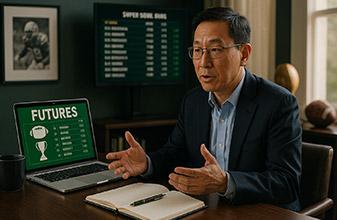Bet spread by count

Green Aces: Cougfan, what’s your bet spread at each count? I'm most interested in seeing at what count you place your max bet.
I don't bet exact, so as to not appear obvious and predictable, but generally I have my max bet out by +4 True Count. At +1 I'm at 2 units, +2 at 4 units, +3 at 7 units, and max (12 units) is at +4 and beyond. I usually spread to two hands at +3 due to the minimum bet requirements on playing two hands. Am I going to my max bet too early?
I wong out at -2. I should probably do more wonging in, but I'm looking at it from the perspective of open tables = more hands/hour. I'm playing drastically less if I wong in rather than play heads up and wong out at -2. I know this will increase my Risk of Ruin. What do you think about this approach?
Playing at my relatively small bankroll is often more of a venture in gaining experience and practicing comportment than anything else, and I think it's important to keep track of the idea that at the lower levels, playing correctly and aggressively is the way to go. I agree with the common wisdom, however, that taking in my surroundings and gaining experience is almost as important as building up my bankroll.
Wonging can be so taxing, but being patient, consistent, and opportunistic is the foundation of being a successful advantage player, in my opinion.
Cougfan: My approach is to treat it as more of an art than a science.
It varies from game to game, but in general my goal is to make sure that I am betting as little as possible (preferably $0) when the count is highly negative, a bit more when the count is in a neutral range, and as much as I can get away with when the count is highly positive (Hi Lo TC +4 or greater). I don't worry about exact bet amounts per count. Rather, I visualize the decks as a spectrum with five iterations or "ranges.” These are: A) Very negative; B) Slightly negative; C) Neutral; D) Slightly positive; and E) Very positive. I also consider where I am at in the shoe. If a count is neutral but there is only one more hand to come after the current one, I may place a bet as if it’s a slightly or even highly negative count. Conversely, if we are early in the shoe, I may err on the side of a slightly higher bet (still within acceptable for that range), so that I am well positioned to quickly get to a huge bet if the count moves into the very positive range.
Hypothetically, if my definition of "huge bet" was $2,000, then I would really like to have at least $1,000 on the table so I can get to the desired amount without making it too obvious. If I am certain that this will be the last hand of the shoe, and the count is anything other than highly positive, then I am probably happy sitting out and/or lowering my bet if I can do so without being too obvious. Like I said, my main concern is getting big money on the table at unquestionably high counts and trying not to bet all that much at other times.
To further complicate matters, I don't have one set bet for each range, but like to move my bets around a bit, preferably not in direct relation to the count movement if at all possible.
All of this increases variance, so I set my simulations a bit more conservatively than my actual plan by moving the boundary for each range one point to my detriment (assume I will be "stuck" betting too much for one extra negative point, and will miss a positive range move by one point as well). I also make sure that the sims still work out to no more than a 0.5% ROR, and a 2% Trip ROR (assuming a maximum number of hours played, which I never actually reach). Yes, I do bring a lot of cash with me on trips, and fortunately I have never run out of funds on a trip, except for the one time I ran out of cash when I was just starting out and before I actually knew how to properly use the sim software.
Note also that the above approach works for me, but definitely should not be used if your bet levels are below the radar of the store you happen to be playing at. If they are, then just follow a regimented bet for each TC and drop all cover.
There is always a bright side: Having a smallish bankroll can make profitable play difficult, but the positive side of that is that your max bets may also fly under the casino's radar, so you can play without cover and can be more aggressive with wong-outs, etc.
There are different advantages and disadvantages for each level of bankroll. One should understand this and adjust their play accordingly so they are playing to the strengths of their game. It’s like playing in a sporting event and adjusting your play to fit your team's strengths and how the referees are calling the game. If you have a small bankroll, play anonymously (comps aren't worth much at low levels anyway), play aggressively, and fire away. As your bankroll grows, seek out different games (tolerance for taking big action becomes one of the most important factors), and employ more finesse in your approach to the game.
My advice to any new AP would be to spend some time in a variety of casinos and observe ploppies betting at the levels you want to bet. See how they act. See how the pit reacts to them. Identify those things they do that sets the pit at ease and emulate those actions. Convince yourself that you are one of the sheep that the pit critter sees as non-threatening. At lower levels, this may be simply being someone who is seemingly not worth the pit’s attention. At higher levels, you WILL get their attention, so you need to know how to redirect it, and how to define yourself in their eyes. An example -- at smaller joints, regulars who bet big (for that place) usually welcome the pit’s attention since they like being treated as an important person after being ignored by their wife, their boss, or whoever. Don't be the type of AP that sticks out like a sore thumb before even placing a single bet!
Originally published on bj21.com Green Chip, edited for this format.











Please log in or register to leave a comment